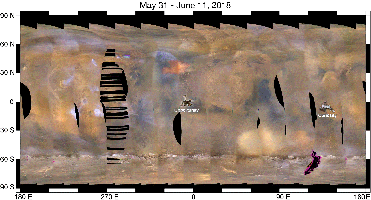One of the thickest dust storms ever observed on Mars has been spreading for the past week and a half. The storm has caused NASA's Opportunity rover to suspend science operations, but also offers a window for four other spacecraft to learn from the swirling dust.
NASA has three orbiters circling the Red Planet, each equipped with special cameras and other atmospheric instruments. Additionally, NASA's Curiosity rover has begun to see an increase in dust at its location in Gale Crater.
"This is the ideal storm for Mars science," said Jim Watzin, director of NASA's Mars Exploration Program at the agency’s headquarters in Washington. "We have a historic number of spacecraft operating at the Red Planet. Each offers a unique look at how dust storms form and behave -- knowledge that will be essential for future robotic and human missions."
Dusty With a Chance of Dust
Dust storms are a frequent feature on Mars, occurring in all seasons. Occasionally, they can balloon into regional storms in a matter of days, and sometimes even expand until they envelop the planet. These massive, planet-scaled storms are estimated to happen about once every three to four Mars years (six to eight Earth years); the last one was in 2007. They can last weeks, or even months at the longest.
The current storm above Opportunity, which is still growing, now blankets 14 million square miles (35 million square kilometers) of Martian surface -- about a quarter of the planet.

Click on the image for the full animation
This set of images from NASA's Mars Reconnaissance Orbiter (MRO) shows a fierce, giant dust storm is kicking up on Mars, with rovers on the surface indicated as icons. The spread of the storm can be seen in the salmon-colored overlay. These images from MRO's Mars Color Imager start from May 31, when the dust event was first detected, and go through June 11, 2018.
MRO creates global maps of Mars but roll maneuvers for targeted observations produce gaps in the coverage, which appear as black gores in the maps. On some days there are data drops where partial or full orbits of coverage are missing. Green and purple observed in the south polar region indicate saturated pixels. Latitude is indicated along the vertical axis. Longitude is indicated along the horizontal axis.
Malin Space Science Systems, San Diego, provided and operates MARCI. NASA's Jet Propulsion Laboratory, a division of Caltech in Pasadena, California, manages the Mars Reconnaissance Orbiter for NASA's Science Mission Directorate, Washington. Lockheed Martin Space Systems, Denver, built the spacecraft.
Image Details
- Mission:
Mars Reconnaissance Orbiter (MRO)
- Target: Mars
- Spacecraft:
Mars Reconnaissance Orbiter (MRO)
- Instrument:
Mars Color Imager (MARCI)
- Views: 758
- Full-Res TIFF: PIA22519.tif
- Full-Res JPG: PIA22519.jpg
- Image credit: NASA/JPL-Caltech/MSSS

No comments:
Post a Comment